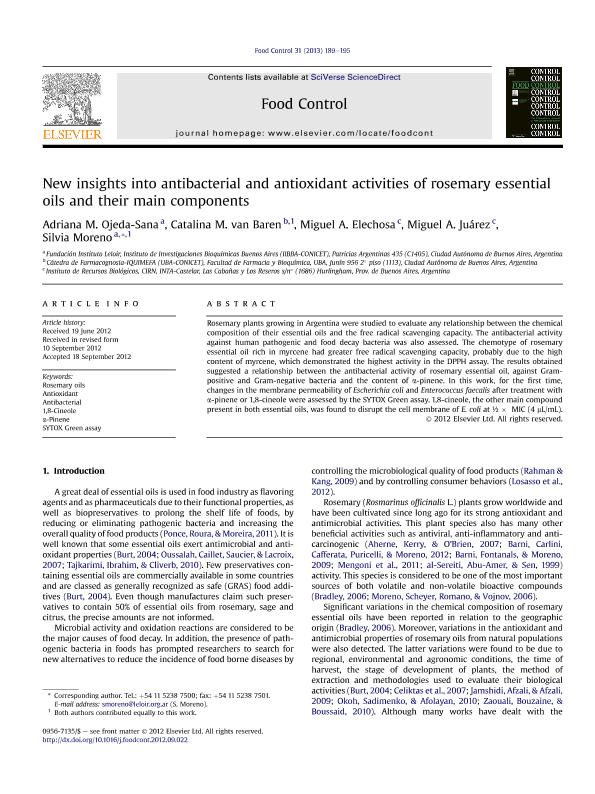Artículo
New insights into antibacterial and antioxidant activities of rosemary essential oils and their main components
Ojeda Sana, Adriana Maria ; Van Baren, Catalina Maria; Elechosa, Miguel A.; Juárez, Miguel A.; Moreno, Silvia
; Van Baren, Catalina Maria; Elechosa, Miguel A.; Juárez, Miguel A.; Moreno, Silvia
 ; Van Baren, Catalina Maria; Elechosa, Miguel A.; Juárez, Miguel A.; Moreno, Silvia
; Van Baren, Catalina Maria; Elechosa, Miguel A.; Juárez, Miguel A.; Moreno, Silvia
Fecha de publicación:
05/2013
Editorial:
Elsevier
Revista:
Food Control
ISSN:
0956-7135
Idioma:
Inglés
Tipo de recurso:
Artículo publicado
Clasificación temática:
Resumen
Rosemary plants growing in Argentina were studied to evaluate any relationship between the chemical composition of their essential oils and the free radical scavenging capacity. The antibacterial activity against human pathogenic and food decay bacteria was also assessed. The chemotype of rosemary essential oil rich in myrcene had greater free radical scavenging capacity, probably due to the high content of myrcene, which demonstrated the highest activity in the DPPH assay. The results obtained suggested a relationship between the antibacterial activity of rosemary essential oil, against Gram-positive and Gram-negative bacteria and the content of α-pinene. In this work, for the first time, changes in the membrane permeability of Escherichia coli and Enterococcus faecalis after treatment with α-pinene or 1,8-cineole were assessed by the SYTOX Green assay. 1,8-cineole, the other main compound present in both essential oils, was found to disrupt the cell membrane of E. coli at 1/2 × MIC (4 μL/mL).
Archivos asociados
Licencia
Identificadores
Colecciones
Articulos(IIBBA)
Articulos de INST.DE INVEST.BIOQUIMICAS DE BS.AS(I)
Articulos de INST.DE INVEST.BIOQUIMICAS DE BS.AS(I)
Citación
Ojeda Sana, Adriana Maria; Van Baren, Catalina Maria; Elechosa, Miguel A.; Juárez, Miguel A.; Moreno, Silvia; New insights into antibacterial and antioxidant activities of rosemary essential oils and their main components; Elsevier; Food Control; 31; 1; 5-2013; 189-195
Compartir
Altmétricas



